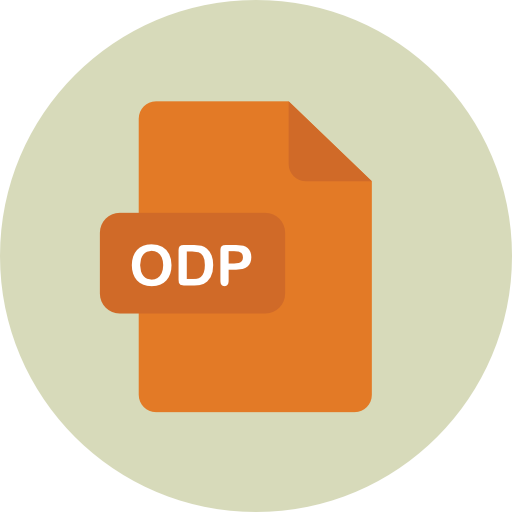.ODP File Extension

OpenDocument Presentation
| Developer | OASIS |
| Popularity | |
| Category | Data Files |
| Format | .ODP |
| Cross Platform | Update Soon |
What is an ODP file?
.ODP (OpenDocument Presentation) file extension is associated with presentation documents created by office suites that adhere to the OpenDocument format.
This open XML-based format is primarily used for creating and displaying presentation slides, akin to Microsoft’s .PPT and .PPTX files used in PowerPoint.
As an open standard, the .ODP format aims to offer a universal and freely accessible alternative for saving and exchanging editable presentation documents.
More Information.
The history of the .ODP file extension is closely tied to the broader narrative of the OpenDocument Format. ODF was developed to provide an open, interoperable format that could be used by any office application, free from the control of any single vendor.
This was seen as a move to foster competition, reduce software costs, and increase collaboration and sharing. The .ODP format, being part of this suite, was specifically designed for presentation documents.
It provided a standardized way to store and exchange presentation information, like slides, text, images, and embedded media.
Origin Of This File.
The .ODP file format is rooted in the OpenDocument Format (ODF), an XML-based file format for spreadsheets, charts, presentations, and word-processing documents. The format was developed by the OASIS industry consortium, with its initial release in May 2005.
The motivation behind the creation of the OpenDocument format, and thereby .ODP files were to provide an open, XML-based file format specification for office applications.
File Structure Technical Specification.
.ODP files, like all ODF documents, are structured as a collection of files within a package (ZIP file). This structure allows for the inclusion of content, styles, metadata, and more in a single, compressed file.
The main components of an .ODP files typically include:
- Content.xml: Holds the actual content of the presentation, like text and layout.
- Styles.xml: Defines the styling information for the presentation.
- Meta.xml: Contains metadata about the document, like the author or the last editing date.
- Settings.xml: Stores application-specific settings related to the document.
This compartmentalization enhances the flexibility and editability of the document and allows for better separation of content and presentation.
How to Convert the File?
Converting .ODP files to other presentation formats like .PPTX or .PDF, or vice versa, ensures compatibility across different software environments. Here’s how you can convert .ODP files:
Using Office Suites:
- LibreOffice or Apache OpenOffice:
- Open the .ODP file in LibreOffice Impress or Apache OpenOffice Impress.
- Go to ‘File’ > ‘Save As’.
- Choose the desired format (e.g., .PPTX, .PDF) and save the file.
- Microsoft PowerPoint:
- Open the .ODP file in PowerPoint.
- Go to ‘File’ > ‘Save As’.
- Choose the desired format and save the file.
Online Conversion Tools:
- Use online services like Zamzar or CloudConvert.
- Upload your .ODP file.
- Select the target format.
- Start the conversion and download the converted file once done.
- Note: Be cautious about privacy when using online converters for sensitive documents.
Command Line (for advanced users):
- Tools like Unoconv can convert files via the command line.
- Example command: unoconv -f pptx presentation.odp
Advantages And Disadvantages.
Advantages:
- Open Standard: Being an open format, .ODP is free from proprietary constraints, reducing dependency on any single software vendor.
- Interoperability: .ODP files can be opened and edited by a wide range of office software, promoting collaboration and data exchange.
- Flexibility: The XML-based structure allows for easy manipulation and custom scripting.
Disadvantages:
- Compatibility Issues: While widely supported, some features in .ODP files may not be fully compatible with non-ODF-compliant software, leading to formatting issues.
- Lesser Adoption: Compared to more widely used formats like .PPTX, the adoption of .ODP is relatively less, which might be a barrier in some professional environments.
How to Open ODP?
Open In Windows
1. LibreOffice or Apache OpenOffice:
- Download and install LibreOffice or Apache OpenOffice.
- Open the software and choose ‘Open File’, or right-click on the .ODP file and select the respective application.
2. Microsoft PowerPoint:
- Right-click on the .ODP file and choose ‘Open with’ > ‘Microsoft PowerPoint’.
- If PowerPoint is the default application for .ODP files, simply double-click the file.
Open In Linux
1. LibreOffice or Apache OpenOffice:
- Most Linux distributions come with LibreOffice pre-installed.
- Open the application, then open the .ODP file through the file menu or right-click on the file and select the application.
2. Via Terminal (for advanced users):
- Use commands like
libreoffice --impress presentation.odporopenoffice -impress presentation.odp.
Open In MAC
1. LibreOffice or Apache OpenOffice:
- Install LibreOffice or Apache OpenOffice for macOS.
- Open the application and load the .ODP file, or right-click on the file and select the application.
2. Apple Keynote:
- Right-click on the .ODP file and select ‘Open with’ > ‘Keynote’.
- Keynote will open and convert the .ODP file to its format.
Open In Android
1. Office Apps:
- Install office apps like Microsoft Office, Google Slides, or AndrOpen Office.
- Open the app and navigate to the .ODP file to open it.
- Some apps may automatically sync your files if you’re using cloud storage.
2. File Managers:
- Use a file manager to locate the .ODP file.
- Tap on the file and select the appropriate office app to open it.
Open In IOS
1. Office Apps:
- Use apps like Microsoft PowerPoint or Google Slides.
- Open the app and navigate to the .ODP file.
- If you’re using cloud services (like iCloud, Google Drive, or OneDrive), the app may automatically sync your files.
2. Apple Keynote:
- Tap on the .ODP file in your file manager or email.
- Select ‘Copy to Keynote’.
- Keynote will open and possibly convert the .ODP file to its format.













